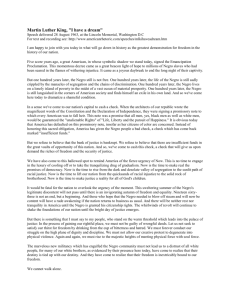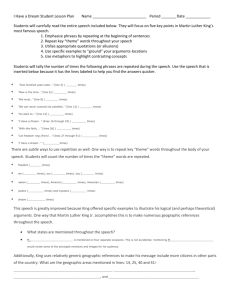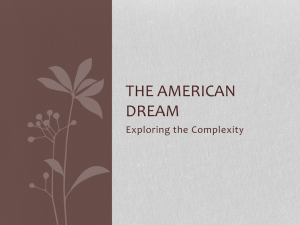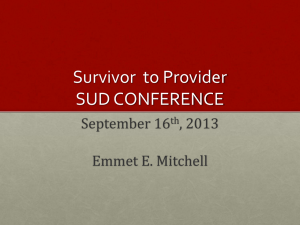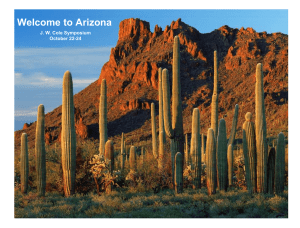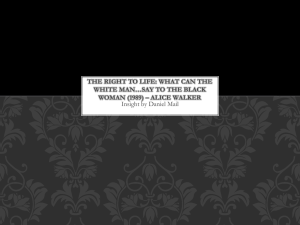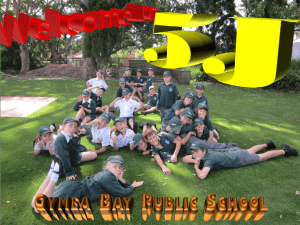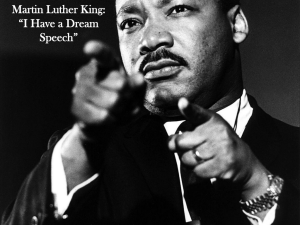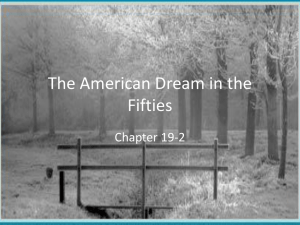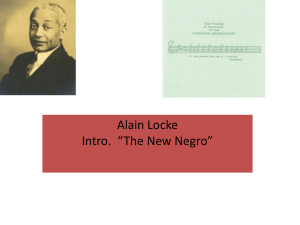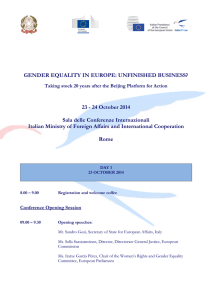I Have a Dream
advertisement
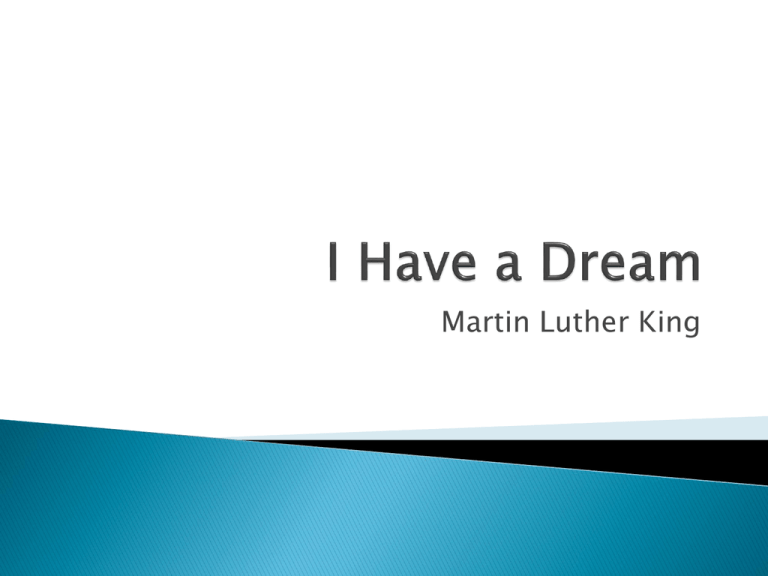
Martin Luther King Imagery Antithesis Anaphora Non-literal comparisons (metaphor, simile, personification) “Let freedom ring” Often used by King to visualise/ dramatise abstract concepts such as freedom and justice. His sue of imagery also makes the speech more striking Bringing together of apparent opposites “This sweltering summer of the Negro's legitimate discontent will not pass until there is an invigorating autumn of freedom and equality.” Used to highlight the difference between the current situation of racial injustice and the dream of equality. The repetition of key phrases at the start of clauses. Used to give the speech a sense of urgency, which matches the urgency of the cause Helps key phrases stand out Helps build towards certain climaxes Write down three things you know about King and the context of the speech In 1963, southern states featured not only separate black and white schools, churches, and neighbourhoods, but also separate black and white restrooms, drinking fountains, hotels, motels, restaurants, cafes, golf courses, libraries, elevators, and cemeteries. African-Americans were also systematically denied the right to vote. Southern whites could commit crimes against blacks-- including murder--with little or no fear of punishment. Racism also conditioned life in the North. Although segregationist practices directly violated the Fourteenth and Fifteenth Amendments of the Constitution, the federal government exerted little or no effort to enforce these amendments. Leading politicians--including John Kennedy, Robert Kennedy, and Lyndon Johnson--advocated racial equality only when pressured by King and other activists Born January 15, 1929 A Baptist minister Leader of the civil rights movement Worked to end racial discrimination and segregation through non-violent civildisobedience Assassinated on April 4, 1968 The key message in the speech is that all people are created equal and, although not the case in America at the time, King felt it must be the case for the future. Simple yet effective structure First half of speech catalogues an American nightmare of racial injustice and inequality; King excoriated a nation that espoused equality while forcing blacks onto "a lonely island of poverty in the midst of a vast ocean of material prosperity." The second half of the speech paints the dream of a better, fairer future of racial harmony and integration. The speech, from the steps of the Lincoln Memorial during the March on Washington for Jobs and Freedom, was a defining moment of the American Civil Rights Movement. Delivered to over 200,000 civil rights supporters. 16th President of America Led the country through the American Civil War Ended slavery in America Delivered at the dedication of the Soldiers' National Cemetery in Gettysburg, Pennsylvania, on Thursday, November 19, 1863. Lincoln asserted the nation was born, not in 1789, but in 1776, "conceived in Liberty, and dedicated to the proposition that all men are created equal. He declared that the deaths of so many brave soldiers would not be in vain, that slavery would end as a result of the losses, and the future of democracy would be assured, The Emancipation Proclamation, issued on September 22, 1862 and put into effect on January 1, 1863, freed slaves in territories not already under Union control. Promised freedom and civil rights to the former slaves and all African Americans. By 1963, these promises were largely unfulfilled. I am happy to join with you today in what will go down in history as the greatest demonstration for freedom in the history of our nation. First paragraph is greeting and unification Reminder of purpose of demonstration Our nation- both black and white Five score years ago, a great American, in whose symbolic shadow we stand today, signed the Emancipation Proclamation. This momentous decree came as a great beacon light of hope to millions of Negro slaves, who had been seared in the flames of withering injustice. It came as a joyous daybreak to end the long night of their captivity. But one hundred years later, the Negro still is not free. One hundred years later, the life of the Negro is still sadly crippled by the manacle of segregation and the chains of discrimination. ‘Five score years ago’ use of biblical language, also quoting from the Gettysburg Address a great American- Lincoln in whose symbolic shadow we stand today- works both literally (King is actually speaking in the shadows of the Lincoln Memorial) and figuratively (King is using his words) Reference to EP foregrounds the promises of equality made one hundred years ago. This momentous decree came as a great beacon light of hope to millions of Negro slaves, who had been seared in the flames of withering injustice. Momentous- of utmost importance Decree- rule of law passed by a head of state Beacon light- a guiding light, such as that on a lighthouse, helps those in danger Seared- burnt at the surface Withering – affect harmfully a great beacon light of hope to millions of Negro slaves, who had been seared in the flames of withering injustice. This metaphor compares the emancipation proclamation to a guiding light of hope and promise to lead African Americans out of the abject cruelty of slavery and towards justice. Biblical language is used- light carries allusions to God’s light/ goodness; flames carries obvious connotations of hell. It came as a joyous daybreak to end the long night of their captivity. Antithesis used to highlight the contrast between the long misery of slavery and the hope brought about the Emancipation Proclamation. Again a contrast between light and dark is used. But one hundred years later, the Negro still is not free. One hundred years later, the life of the Negro is still sadly crippled by the manacle of segregation and the chains of discrimination. Highlights contrast between the hope of freed slaves in 1863 and the disappointment of African Americans in 1963. Start of repetition of ‘One hundred years later’. This is repeated to highlight how little has changed over such a long period a time Manacles were shackles used for fastening slaves’ hands and feet. One hundred years later, the Negro lives on a lonely island of poverty in the midst of a vast ocean of material prosperity. One hundred years later, the Negro is still languishing in the corners of American society and finds himself an exile in his own land. So we've come here today to dramatize a shameful condition. Anaphora used here Imagery used to highlight how African Americans are excluded from American society. The image of the island gives the idea of alienation/ isolation. King’s plea is for integration of African Americans into mainstream American society. In a sense we've come to our Nation's Capital to cash a cheque. When the architects of our republic wrote the magnificent words of the Constitution and the Declaration of Independence, they were signing a promissory note to which every American was to fall heir. Start of the extended metaphor of the banking system. This compares the promises of equality and liberty made in the Emancipation Proclamation to promises of financial payment. A promissory note is an instrument wherein one party makes an unconditional promise in writing to pay a sum of money to the other, either at a fixed or determinable future time or on demand of the payee,. Opening written by Thomas Jefferson, third President of the U.S.A. We hold these truths to be self-evident, that all men are created equal, that they are endowed by their Creator with certain unalienable rights, that among these are Life, Liberty, and the Pursuit of Happiness. This note was a promise that all men, yes, black men as well as white men, would be guaranteed the inalienable rights of life, liberty and the pursuit of happiness. Use of allusion, borrowing from the Declaration of Independence. King is positioning African Americans’ struggle for civil rights as a renewal of America’s founding values. It is obvious today that America has defaulted on this promissory note insofar as her citizens of colour are concerned. Instead of honouring this sacred obligation, America has given the Negro people a bad cheque, a cheque which has come back marked "insufficient funds.“ There is a shift in emphasis in the extended metaphor here. King highlights that the promised ‘payments’ of the Emancipation Proclamation have not materialised; African Americans are still oppressed, second-class citizens. But we refuse to believe that the bank of justice is bankrupt. We refuse to believe that there are insufficient funds in the great vaults of opportunity of this nation. So we have come to cash this check, a check that will give us upon demand the riches of freedom and the security of justice. Imagery/ extended metaphor used to equate America with bank/ vaults. Just as these store great wealth, America stores great possibilities for African Americans in the possibility of true justice, equality and democracy. Repetition of ‘cash a cheque’ at climax of the extended metaphor. We have also come to this hallowed spot to remind America of the fierce urgency of Now. This is no time to engage in the luxury of cooling off or to take the tranquilizing drug of gradualism. Hallowed spot- holy ground King is establishing the crucial importance of civil rights happening immediately. It is not an issue that can be ignored or postponed. Now is the time to make real the promises of democracy. Now is the time to rise from the dark and desolate valley of segregation to the sunlit path of racial justice. Anaphora used to stress the urgency of the situation. Antithesis used to highlight the transformation in American society that King wishes to see. Alliteration of ’d’ and word choice of ‘desolate’ equate segregation with despair. This contrasts with the positive word choice of ‘rise’ ‘sunlit’ and ‘justice’. Now is the time to lift our nation from the quick sands of racial injustice to the solid rock of brotherhood. Now is the time to make justice a reality for all of God's children. ‘Quicksand’ suggests something perilous and unstable; ‘solid rock’ suggests a solid foundation. It would be fatal for the nation to overlook the urgency of the moment. This sweltering summer of the Negro's legitimate discontent will not pass until there is an invigorating autumn of freedom and equality. Nineteen sixty-three is not an end but a beginning. Those who hope that the Negro needed to blow off steam and will now be content will have a rude awakening if the nation returns to business as usual. "Now is the winter of our discontent" are the opening words of Shakespeare’s Richard III and lay the groundwork for the portrait of Richard as a discontented man who is unhappy in a world that hates him. It is natural for autumn to follow summer; it is natural and right for all people to be given equality. There will be neither rest nor tranquillity in America until the Negro is granted his citizenship rights. The whirlwinds of revolt will continue to shake the foundations of our nation until the bright day of justice emerges. King threatening disharmony in America until racial equality occurs. More use of natural imagery. But there is something that I must say to my people who stand on the warm threshold which leads into the palace of justice. In the process of gaining our rightful place we must not be guilty of wrongful deeds. Threshold- doorway/ entrance Imagery used to make justice seem grand, equating it with the wealth of America. Warning against violence. Let us not seek to satisfy our thirst for freedom by drinking from the cup of bitterness and hatred. We must forever conduct our struggle on the high plane of dignity and discipline. We must not allow our creative protest to degenerate into physical violence. Again and again we must rise to the majestic heights of meeting physical force with soul force. Imagery here equates freedom with something we need to survive. It also suggests that to be deprived of this can understandably lead to violence. King creates a contrast between violence as low and the heights (high plane) of non-violent direct action. The marvellous new militancy which has engulfed the Negro community must not lead us to a distrust of all white people, for many of our white brothers, as evidenced by their presence here today, have come to realize that their destiny is tied up with our destiny and they have come to realize that their freedom is inextricably bound to our freedom. We cannot walk alone. In this section king turns from advocating nonviolence to underlining the importance of integration and cooperation between the races. Highlighting that equality benefits white Americans as well as African Americans. And as we walk, we must make the pledge that we shall always march ahead. We cannot turn back. There are those who are asking the devotees of civil rights, "When will you be satisfied?" We can never be satisfied as long as the Negro is the victim of the unspeakable horrors of police brutality. Repetition of ‘we’ to underline that black and white are working together for civil rights. King’s audience at the demonstration contained many white Americans. Starts to use anaphora ‘we can never be satisfied’ to highlight the reasons why they are there for the protest. We can never be satisfied as long as our bodies, heavy with the fatigue of travel, cannot gain lodging in the motels of the highways and the hotels of the cities. We cannot be satisfied as long as the Negro's basic mobility is from a smaller ghetto to a larger one. We can never be satisfied as long as our children are stripped of their selfhood and robbed of their dignity by signs stating "for white only." We cannot be satisfied as long as a Negro in Mississippi cannot vote and a Negro in New York believes he has nothing for which to vote. No, no we are not satisfied and we will not be satisfied until justice rolls down like waters and righteousness like a mighty stream. Climax of ‘we cannot be satisfied’ section Powerful imagery used to highlight what they are seeking- justice and equality. Comparison to water continues the imagery of thirst and drinking (needed for life) It also suggests something powerful, inevitable and unstoppable. This is a biblical allusion to Amos 5:24 I am not unmindful that some of you have come here out of your trials and tribulations. Some of you have come fresh from narrow jail cells. Some of you have come from areas where your quest for freedom left you battered by the storms of persecutions and staggered by the winds of police brutality. Anaphora and imagery used to highlight the suffering and persecution faced by many who were attending the march. You have been the veterans of creative suffering. Continue to work with the faith that unearned suffering is redemptive. Go back to Mississippi, go back to Alabama, go back to South Carolina go back to Georgia, go back to Louisiana, go back to the slums and ghettos of our northern cities, knowing that somehow this situation can and will be changed. Transitional moment of the speech. King finishes outlining the nightmare of racial injustice and segregation in America 1963 and starts to outline his dream of how it will change. Let us not wallow in the valley of despair. I say to you today, my friends, so even though we face the difficulties of today and tomorrow. I still have a dream. It is a dream deeply rooted in the American dream. valley of despair- biblical reference to when the Jews had to flee Israel because of religious persecution. Word choice of ‘despair’ suggests a feeling of hopelessness. At its introduction, King’s dream is connected with the American dream. The national ethos / belief system of the United States of America Freedom includes the possibility of prosperity and success "life should be better and richer and fuller for everyone, with opportunity for each according to ability or achievement“ Rooted in the United States Declaration of Independence - which proclaims that "all men are created equal" and that they are "endowed by their Creator with certain inalienable Rights" including "Life, Liberty and the pursuit of Happiness. I have a dream that one day this nation will rise up... live out the true meaning of its creed. We hold these truths to be self-evident that all men are created equal. Creed- system of beliefs King again refers to the Declaration of Independence, thereby connecting his dream and the American dream. I have a dream that one day on the red hills of Georgia the sons of former slaves and the sons of former slave owners will they be able to sit down together at the table of brotherhood. King is now starting to depict his dream of racial equality, justice and harmony Georgia- a south-eastern American state I have a dream that one day even the state of Mississippi, a state sweltering with the heat of injustice, sweltering with the heat of oppression will be transformed into an oasis of freedom and justice. Repetition used to highlight the current nightmarish situation in racist Southern states. Antithesis used to convey how King sees this changing. An oasis is a sheltered or fertile spot in a desert. Therefore, this contrasts with the ‘sweltering heat of oppression’. I have a dream that my four little children will one day live in a nation where they will not be judged by the colour of their skin but by the content of their character. I have a dream today. Simple, yet extremely effective use of contrast I have a dream that one day down in Alabama, with its vicious racists, with its governor having his lips dripping with the words of interposition and nullification; one day right down in Alabama little black boys and black girls will be able to join hands with little white boys and white girls as sisters and brothers. I have a dream today. Nullification and Interposition- legal attempts made by some southern states to prevent integrated schooling. Simple image used to portray future of racial harmony I have a dream that one day every valley shall be exalted, every hill and mountain shall be made low, the rough places will be made plains and the crooked places will be made straight and the glory of the Lord shall be revealed and all flesh shall see it together. Biblical allusion to Isaiah 40:4. here King is explicitly connecting his dream and the struggle of African Americans with God’s work. This is our hope. This is the faith that I go back to the South with. With this faith we will be able to hew out of the mountain of despair a stone of hope. First part of the antithesis suggests a seemingly insurmountable obstacle; the word choice reminds us of the ‘dark and desolate valley’. With this faith we will be able to transform the jangling discords of our nation into a beautiful symphony of brotherhood. Discords- An inharmonious combination of simultaneously sounded tones Symphony- Something characterized by a harmonious combination of elements Antithesis suggests that America is currently a land of disharmony. Yet, in King’s dream the races work and live in harmony. With this faith we will be able to work together, to pray together, to struggle together, to go to jail together, to stand up for freedom together, knowing that we will be free one day. Effective sentence structure/ repetition used to highlight unity of black and white, building up to climax of freedom. This will be the day; this will be the day when all of God's children are able to sing with new meaning "My country 'tis of thee, sweet land of liberty, of thee I sing. Land where my fathers died, land of the Pilgrim's pride, from every mountainside, let freedom ring!“ Ironic use of patriotic American song. In 1963, the lyrics of this song did not reflect the experiences of African Americans. And if America is to be a great nation, this must become true. So let freedom ring from the prodigious hilltops of New Hampshire. Let freedom ring from the mighty mountains of New York. Let freedom ring from the heightening Alleghenies of Pennsylvania. Let freedom ring from the snow-capped Rockies of Colorado. Let freedom ring from the curvaceous slopes of California. But not only that, let freedom, ring from Stone Mountain of Georgia. Let freedom ring from Lookout Mountain of Tennessee. Let freedom ring from every hill and molehill of Mississippi from every mountainside. And when this happens, and when we allow freedom to ring, when we let it ring from every village and every hamlet, from every state and every city, we will be able to speed up that day when all of God's children, black men and white men, Jews and Gentiles, Protestants and Catholics, will be able to join hands and sing in the words of the old negro spiritual, "Free at last, free at last. Thank God Almighty, we are free at last." Speech concludes by reiterating King’s message of unity. Repetition of ‘we’ and ‘every’ Bringing together seemingly opposite groups of cultures. Image of celebration created ‘Free at last’ from a Negro spiritual song.
